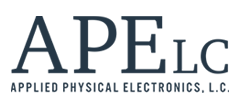APELC was founded in 1998, rooted in the CEO’s graduate school innovations. We understand the challenges faced by universities in accessing reliable and user-friendly research equipment & support. Unlike typical university lab hardware, which can be temperamental, our matured products offer ease of use and reliability. By providing turn-key systems, APELC empowers researchers to focus on quality research rather than hardware development.
APELC’s Collaboration with Universities
APELC supports universities in various ways…
Equipment Funding Support: Through programs like the DURIP grant, APELC provides turn-key pulsed power systems, ensuring cost efficiency and timely delivery to maximize research time.
Fundamental Research and Development Support: Through programs such as STTR, APELC can support in multiple capacities, as technology transfer partners, consultants, equipment suppliers, or manufacturing partners, facilitating fundamental research and development.
APELC Quick-Disconnect Coaxial Connector Sampling Program: Our connector sampling program offers universities access to high-reliability connectors, streamlining laboratory prototypes and enhancing research efficiency. You can learn more about our connectors in this press release which discusses our contract with Los Alamos National Labs. To request your free connectors, contact us here.

Key Applications of APELC Products in University Research
High-Power Microwaves
APELC Marx generators serve as excellent pulsed power drivers for studying HPM generation and effects. Ranging from compact models like the MG15-3C-940PF to larger PFN Marxes such as the MG24-20C-2700PF-PFN, these generators are available as turn-key systems. This allows researchers to focus on optimizing the HPM source without investing valuable time in designing and manufacturing pulsed power systems.
Fusion
APELC offers Marx Generators, capacitive discharge circuits, trigger generators, spark gaps, and high-voltage connectors for fusion research. Our manufacturing services are tailored for creating designs originating from university research. With our expertise, we not only fabricate designs but also provide testing and troubleshooting support.
Pulsed Power
With over 25 years of experience, APELC collaborates with university partners to develop advanced pulsed power technology. Our products provide mature, time-tested components, ensuring focus on research and development without compromising quality and reliability.
Plasma Research
APELC designs and manufactures a wide range of pulse generators suitable for plasma research, including low-temperature plasmas. Our extensive product line offers solutions beyond what is listed on our website, catering to diverse research needs. A great place to start is with our Marx Generators page, where you can look for pulse characteristics that match the specific needs of your research. That said, if you don’t see what you need on our website, please drop us a line at info@apelc.com
Lightning Research
APELC specializes in designing and manufacturing pulsed power systems for studying near-strike and direct-strike lightning phenomena.
Electromagnetic Pulse (EMP) Research
Given the threat of high-altitude nuclear EMPs (HEMP), universities collaborate with federal agencies to study their effects. APELC provides a comprehensive suite of HEMP and high-power RF test systems for conducted and radiated susceptible studies.
Environmental Mitigation
Our pulsed power systems contribute to environmental mitigation efforts by producing low-temperature plasmas, corona, ozone, and electrical discharges. These are used to purify air, water, surfaces, and soil contaminated by environmental pollutants.
Materials Processing and Food Processing
APELC’s pulsed-power driven technologies play a crucial role in various material, food, and agricultural processes. By altering chemical compositions, these technologies aid in manufacturing and ensuring food safety.
Electrical Discharge Studies
APELC provides pulsed high-voltage sources and assists in designing and manufacturing test stands and electrodes for studying electrical discharge phenomena.
Additional Funding Resources
Exploring funding opportunities is crucial for universities seeking to enhance their research capabilities. Here are some examples of funding sources we have encountered while collaborating with our university partners:
Multidisciplinary University Initiative (MURI):
The MURI program, offered by the Department of Defense, typically awards around $1.5 million per year for a 3 to 5-year period. While primarily aimed at supporting academic faculty salaries, funding for equipment purchases may be considered if demonstrated as necessary.
-
- Website: Department of Defense – MURI
- Search “MURI” at Grants.gov
Helpful Links:
-
- https://www.nre.navy.mil/work-with-us/funding-opportunities/fiscal-year-fy-2025-department-defense-multidisciplinary
- https://www.afrl.af.mil/About-Us/Fact-Sheets/Fact-Sheet-Display/Article/2282120/afosr-funding-opportunities-university-research-initiative-uri/
- https://arl.devcom.army.mil/collaborate-with-us/opportunity/muri/
Defense University Research Instrumentation Program (DURIP):
DURIP funding is tailored for purchasing equipment and instrumentation to facilitate fundamental academic research aligned with the Department of Defense’s objectives. Proposals can request up to $3 million for augmenting or establishing new capabilities within university laboratories.
-
- Websites:
- Navy Research Office – DURIP
- Basic Research – DURIP
- Search “DURIP” at Grants.gov
- Websites:
Helpful Links:
Small Business Technology Transfer (STTR):
The STTR program, part of the Small Business Innovative Research (SBIR) initiative, facilitates collaboration between small businesses and universities for fundamental research. Phase 1 awards range from $50k to $250k and focus on initial research and design, while Phase 2 awards, averaging $750k, emphasize hardware development.
-
- Learn more at SBIR.gov
- Search for SBIR/STTR opportunities with specific agencies, e.g., “Air Force SBIR.”
Additionally, universities may explore federal programs listed by institutions like Michigan Tech for equipment purchase opportunities. Internal funding avenues, including endowments, donations, and residual funds from fiscal years, can also support equipment purchases, often administered through college engineering departments or Dean’s offices.
